© ROOT-NATION.com - Use of content is permitted with a backlink.
Today let’s talk about the legendary A-10 Thunderbolt II attack aircraft. The possibility of this aircraft to serve in the Air Force of Ukraine has been discussed recently. But do our pilots need it?
The news that the A-10 Thunderbolt II attack aircraft “may” appear in our Armed Forces quickly spread across the Internet and caused a wave of discussion and controversy. But it is worth considering that in this particular case “may” is an extremely loose interpretation of the words of US Air Force Chief of Staff Charles Q. Brown, Jr. and US Air Force Secretary Frank Kendall III during the Aspen Security Forum. That is, nothing has been decided yet, but there are such prospects.
Control of the airspace is the key to victory on the ground
Only the lazy did not write or speak about problems with aircrafts in our confrontation with the Russian occupiers. Yes, there are problems, and they are big enough. This was especially noticeable at the beginning of the war, when Russian planes bombarded Ukrainian cities with almost impunity, spreading panic and fear. It should be noted that the Ukrainian Air Force successfully struck the planes, helicopters and drones of the invaders. We all remember the legendary “Ghost of Kyiv”, we remember Russian planes downed by Stinger systems. But everyone understands that the superiority in the air is still with the Russians. The events in Mariupol and Severodonetsk proved that, unfortunately, we cannot overcome this horde without aviation.
I note that the Air Force of Ukraine is equipped with outdated versions of MiG and Su, which we inherited from Soviet times. Yes, these are modernized, updated models, but they are clearly inferior to the latest models of Russian aircraft. Only thanks to the courage and skill of our air aces can we resist Russians in the air. Western partners tried to find old MiG-29s and Su-27s in Eastern Europe, which were once in service in these countries, but the stocks are small, and, for the most part, these planes are in a deplorable condition. Therefore, the question arose of equipping the Air Force of Ukraine with NATO-type aircraft, as is currently the case with artillery. By the way, such a transition has already proven its effectiveness on the battlefield.
The search for acceptable options for the Ukrainian Air Force has begun. There have been talks about the F-15 and F-16, but these talks are nothing more than a discussion. The Minister of Defense of Ukraine also named Gripen, Dassault Rafale and Eurofighter Typhoon among the possible options. All this is just talk and guesswork. As I wrote above, US Air Force Chief of Staff Charles Q. Brown, Jr. and US Air Force Secretary Frank Kendall III called the A-10 Thunderbolt II attack aircraft a likely option. Let’s talk about this legendary attack aircraft today and find out whether it can be a successful acquisition for the Air Force of Ukraine.
Recommended reading: Weapons of Ukrainian victory: ATGM Stugna-P — Russian tanks are in trouble
What is interesting about the A-10 Thunderbolt II?
It should be said that the A-10 Thunderbolt II is a truly legendary piece of equipment that has managed to gain fame through successful combat use in many armed conflicts.
When we talking about combat aircraft, it is not difficult to find models that remain relevant for a long period of operation. The F-15 is undoubtedly one of the most iconic. But there are other planes that have been in service for several decades and are not yet close to retirement, although they have not been produced for a long time. The most famous example is the Fairchild Republic A-10 Thunderbolt II, or Warthog.
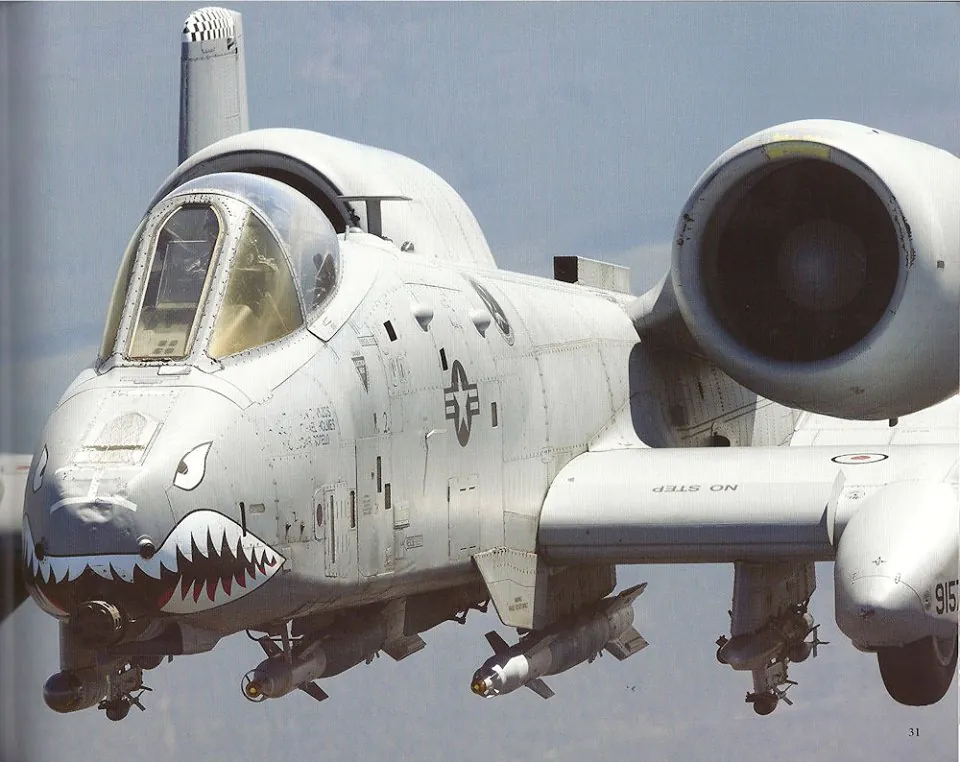
This twin turbofan attack aircraft entered service in the late 1970s and began to play a key role in close air support missions. It has received a significant number of upgrades since its introduction, and it is believed that hardware improvements and a new wing design developed by Boeing will allow it to continue its service until 2040.

Due to its legendary success in many combat conflicts, as well as its unique aesthetics, the A-10 Warthog has gained a real cult status among fans of military aviation. This is confirmed by its appearance in many movies and video games, such as “Transformers”, “Terminator: Salvation”, “Man of Steel”, “Ace Combat” franchise, to name a few. Indeed, this attack aircraft became a legend and received a whole army of fans around the world.
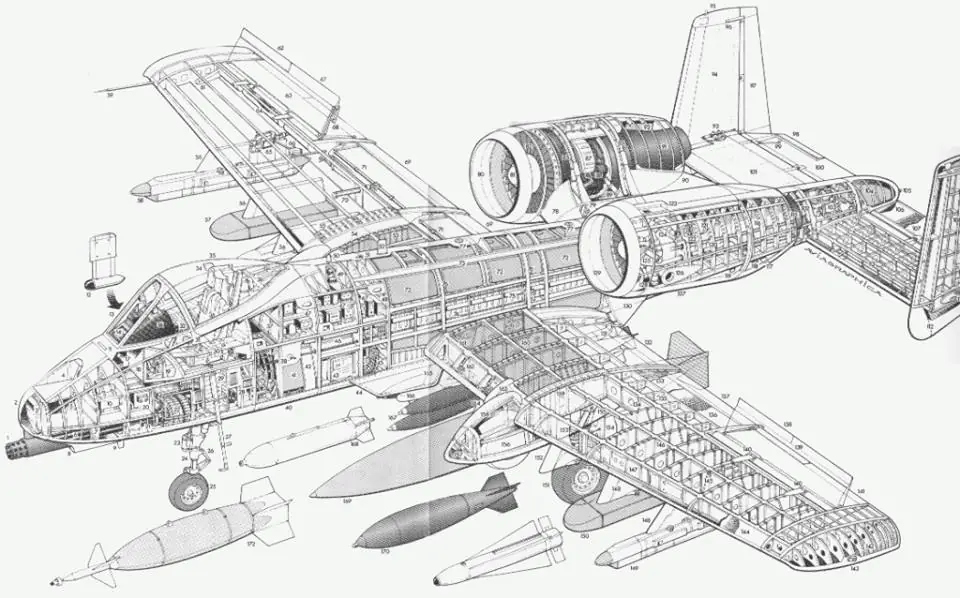
Recommended reading: Comparison of F-15 Eagle and F-16 Fighting Falcon fighters: pros and cons
A-10 Thunderbolt II “Warthog”, a combat aircraft that defies time
The development of the A-10 Thunderbolt II arose from the need of the US Air Force for an aircraft that would provide air support for ground forces. During the Vietnam War, it became obvious that the Douglas A-1 Skyraider attack aircraft, which was developed in the second half of the 1940s, although proved its effectiveness, had many shortcomings and high vulnerability, even for small arms. This aircraft was clearly outdated and needed immediate replacement.
In September 1966, the USAF decided to begin development of a new attack aircraft, and within months the AX program was officially launched. More than twenty representatives of the arms industry received an offer to participate in the development, but only in 1970 more precise criteria were established for the capabilities of this aircraft project.
The most important element of the design should have been an installation of a 30-mm rotating barrel. The aircraft was supposed to have a range of 460 km, a maximum speed of 740 km/h and carry an external load of more than 7,000 kg.
With these criteria in mind, the US Air Force narrowed the list of potential manufacturers to two candidates: Fairchild Republic and Northrop Corporation. Both companies were tasked with the production of prototypes in order to choose a winner after appropriate tests.
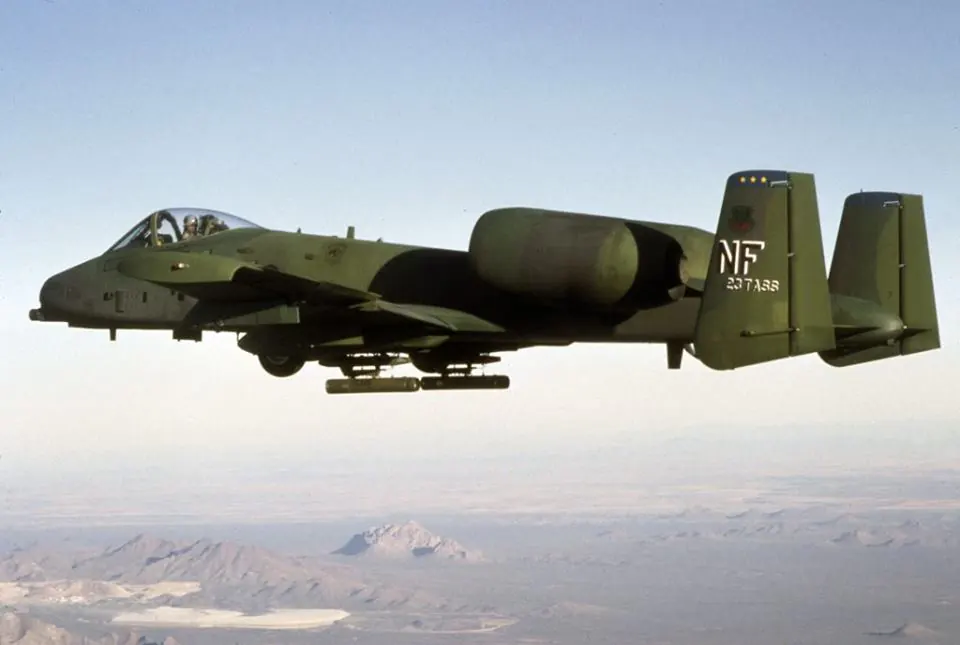
Finally, in January 1973, the US Air Force settled on the Fairchild Republic model, which received the official designation A-10 Thunderbolt II. Warthog deliveries to various units of the Air Force began in 1976, and in October 1977 it was officially adopted by the United States Air Force.
Production of the A-10 Warthog lasted until 1984, with a total of 715 units produced. It is worth noting that since its appearance, this aircraft has been operated exclusively by the US Air Force. Not only was it prohibited from being attached to any other branch of the US military, but it was also prohibited from being sold to international customers.
It should be said that more than 367 A-10 Thunderbolt II aircraft of 2 modifications are currently in service at the US Air Force: Active force, A-10 – 143 and OA-10 – 70; Air Force Reserve, A-10 – 46 and OA-10 – 6; Air National Guard, A-10 – 84 and OA-10 – 18
In June 2007, Boeing received a $2 billion contract for the A-10 Thunderbolt II wing replacement program. Boeing delivered 242 sets of replacement wings in 2018.
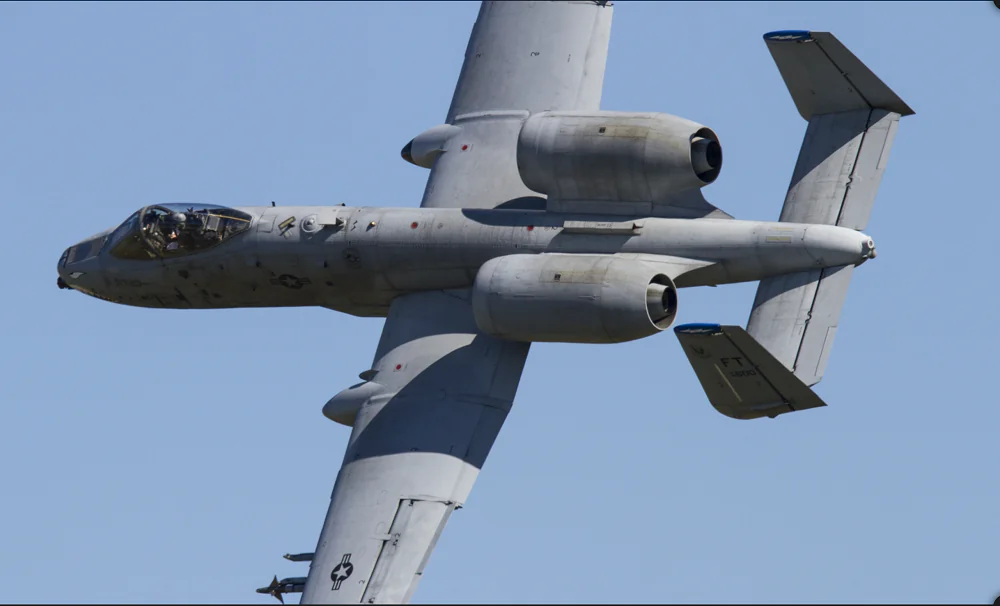
Also in September 2009, the US Air Force signed two $4.2 million contracts with Boeing to upgrade its fleet of 365 A-10 Thunderbolt II aircraft over a period of 3 to 18 months. The contract was signed as part of the A-10 Thunderbolt II lifecycle modernization program with a total cost of $1.6 billion.
In August 2019, Boeing received a $999 million contract from the US Air Force to perform maintenance work on the A-10 Thunderbolt II aircraft. The 11-year contract provided for the production of 112 new wing assemblies and 15 wing kits.
These two contracts relate to the structural integrity program for the A-10 Thunderbolt II aircraft. It included the provision of engineering services for the aircraft and the upgraded data transmission unit, as well as analysis of commercial studies. Both contracts aim to upgrade the aircraft’s avionics to improve memory and data capabilities. That is, the A-10 Thunderbolt II is constantly undergoing modernization, improvement of avionics, weapons, etc.
Now let’s get to know the hero of my story in more detail.
Recommended reading: All about the 155mm M777 howitzer and M982 Excalibur guided projectile
A-10 Thunderbolt II design
The A-10 Thunderbolt II has excellent maneuverability at low speeds and altitudes thanks to its large wing area, low wing angle and large ailerons. The wing design also allows for short take-offs and landings, making it possible to use primitive airfields near the front line. The aircraft can stay in the air for a long period and operate at an altitude of 300 m with a visibility of up to 2.4 km. The aircraft typically has a relatively low speed of around 560 km/h, making it more suitable for ground attack than fast fighter-bombers, which often have difficulty targeting small and slow targets.
The panel construction of the leading edge of the wing has a honeycomb structure that provides strength at a minimum weight, similar panels cover the flaps, elevators and keel sections. Combat experience has shown that this type of panels is more resistant to damage. The ailerons are located at the far ends of the wings to increase rolling moment and have two distinctive features: the ailerons themselves cover almost half of the wingspan, providing improved control even at low speeds, they are split and also act as air brakes.

Maintenance, refueling and rearming of the A-10 Thunderbolt II requires minimal equipment. Its simple design allows for maintenance on bases with limited capabilities. An unusual feature is that many parts of the aircraft are interchangeable between the left and right sides, including the engines, main landing gear and vertical stabilizers. A strong landing gear, low-pressure tires and large straight wings allow take-off from short rough strips even with heavy weapons, allowing the aircraft to fly from damaged air bases, take off from taxiways or even straight stretches of highway.
The front landing gear is shifted to the right, which allows you to place the barrel of the 30-mm gun along the axis of the aircraft. The main landing gear wheels partially protrude from the nacelles when retracted, which facilitates landing control on the belly of the gear without damaging the hull. All landing gear struts retract forward if hydraulic power is lost, a combination of gravity and aerodynamic drag can lower and lock the gear in place.
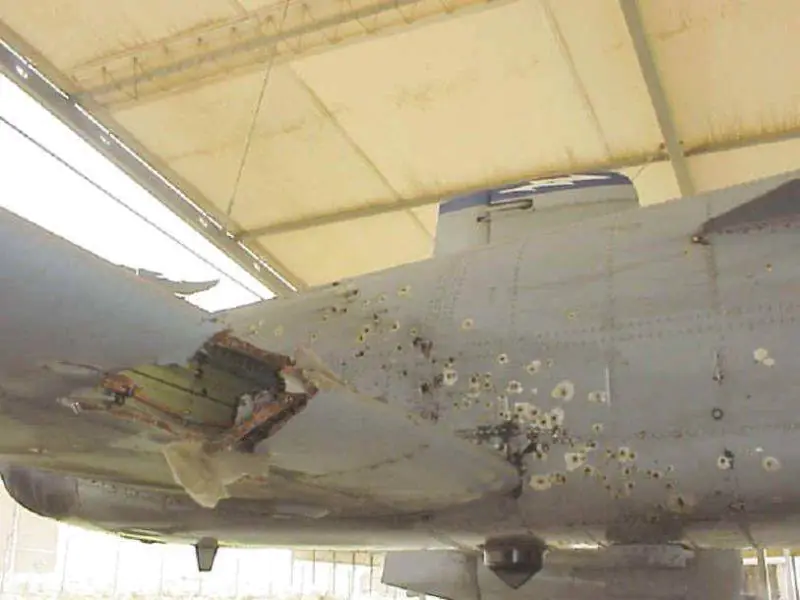
The A-10 Thunderbolt II is exceptionally durable, capable of withstanding direct hits from armor-piercing and high-explosive projectiles of up to 23 mm caliber. It has a dual redundant hydraulic flight system and a mechanical system as a backup in case of loss of hydraulic power. In flight without hydraulic power, a manual reverse control system is used. Pitch and roll control is activated automatically, roll control is selected by the pilot. In manual control mode, the A-10 Thunderbolt II is maneuverable enough to return to base, although it requires more control effort than usual. Amazingly, the plane is designed so that it can fly with one engine, half of the tail, one elevator and half of the wing missing.
Recommended reading: Silent killers of modern warfare: most dangerous military UAVs
Cockpit of the A-10 Thunderbolt II
The single-seater cockpit and flight control panel are protected by 540 kg of titanium armor, a so-called titanium “bathtub” up to 3.8 cm thick to protect the pilot. This armor was tested for its ability to withstand the impact of 23 mm guns and even in some cases 57 mm shells. Armor makes up almost 6% of the weight of an empty aircraft. The cockpit has a large bulletproof canopy that provides a good all-round view.
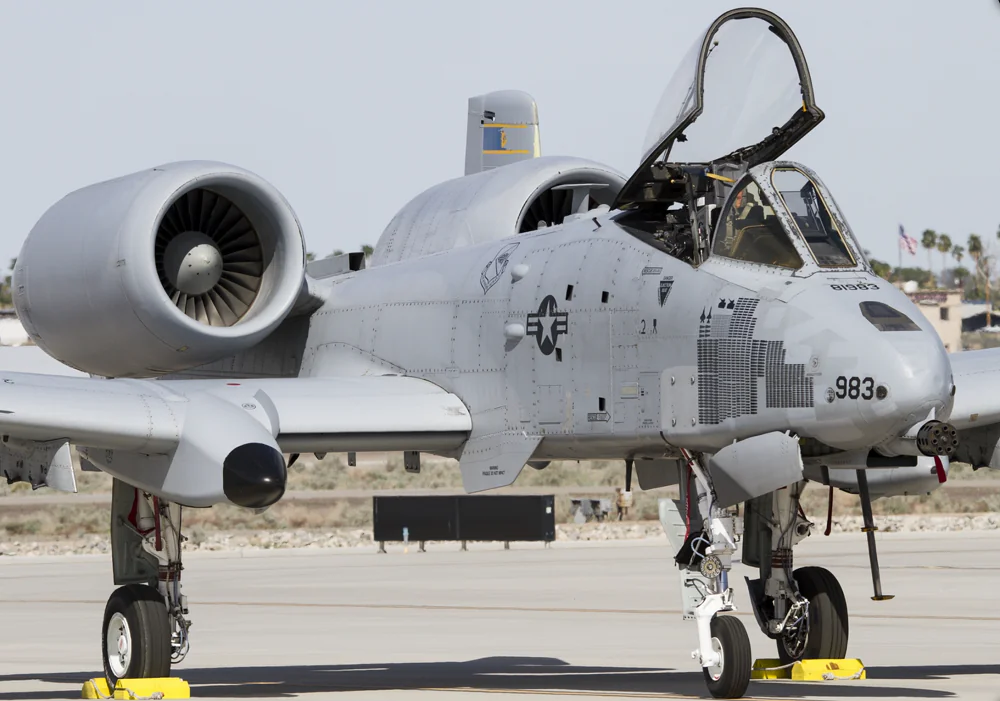
The cockpit is also equipped with a head-up display used for aiming and pointing weapons, the Have-Quick secure radio communication system, inertial navigation and the tactical air navigation system (TACAN).
Lockheed Martin has begun delivery of 21 US Air Force A-10 aircraft with Embedded GPS/INS (EGI) Navigation System, which determines the precise location of the aircraft. The planes are also equipped with BAE Systems terrain profile matching systems (TERPROM).
The pilot is equipped with night vision goggles and a Maverick AGM-65 infrared display.
Recommended reading: Weapons of Ukrainian Victory: Iris-T SLM for Ukraine from Germany
The unusual weaponry of the A-10 Thunderbolt II
The plane has 11 pylons, which provide an external load capacity of 7260 kg. There are three pylons under the fuselage, and the loads can be distributed between the central or two flank fuselage pylons.
The aircraft can be equipped with a Pave Penny laser guidance/electronic support, a platform mounted on the starboard fuselage pylon. Each wing carries four pylons: three outer and one inner, along with the wheel fairing.
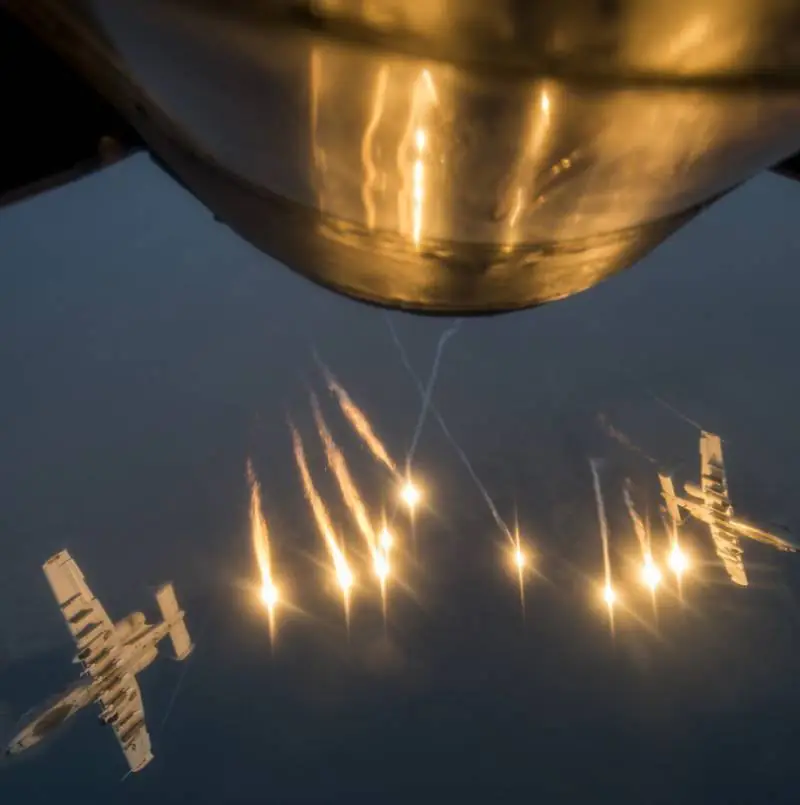
The A-10 Thunderbolt II can carry up to ten Maverick air-to-surface missiles. The Raytheon Maverick AGM-65 missile uses a variety of guidance systems, including infrared guidance and 57 kg high-penetrating cone-shaped warheads. The range is more than 45 km. The A-10 Thunderbolt II can also carry the Sidewinder air-to-air missile, which is a short-range missile with a maximum speed of over Mach 2.
This powerful attack aircraft is capable of using a wide range of munitions, such as the 226 kg LDGP mk82 general-purpose bombs, the BLU-1 and BLU-27/B Rockeye II cluster bombs, and the CBU-52/71 cluster bomb unit.
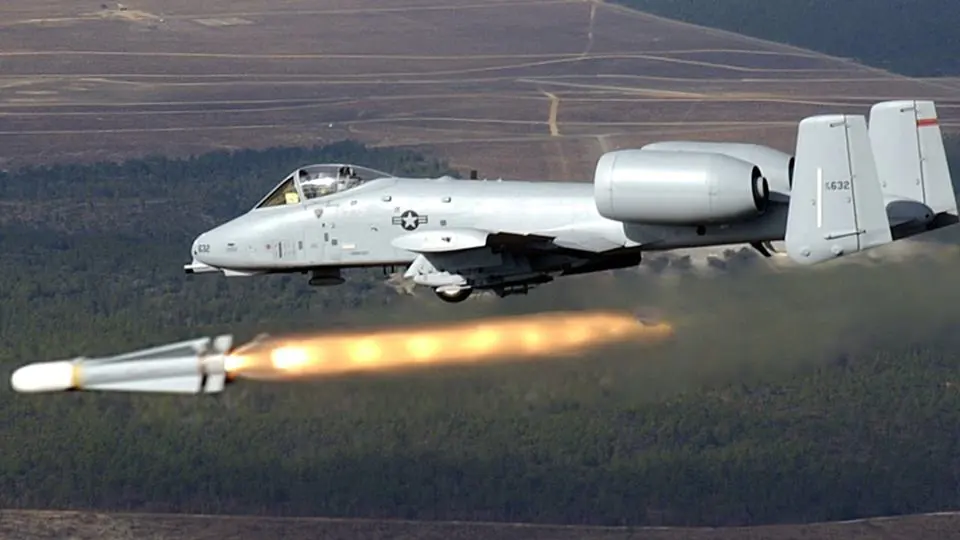
The Northrop Grumman Litening ER (Extended Range) sight pod has been successfully integrated on the A-10 Thunderbolt II. The Litening ER is equipped with a 640×512 pixel thermal imager, CCD TV, laser tracking/rangefinder, IR marker and laser pointer.

The aircraft is armed with a powerful 30-mm General Dynamics GAU-8/A Avenger cannon installed in the nose of the aircraft. With the gun, the attack aircraft is capable of disabling a main battle tank with an effective range of 4,000 feet (1,220 m) with a maximum range of over 12,000 feet (3,660 m). The gun can fire a variety of ammunition, including armor-piercing incendiary (API) projectiles up to 0.75 kg or depleted uranium projectiles of 0.43 kg API.
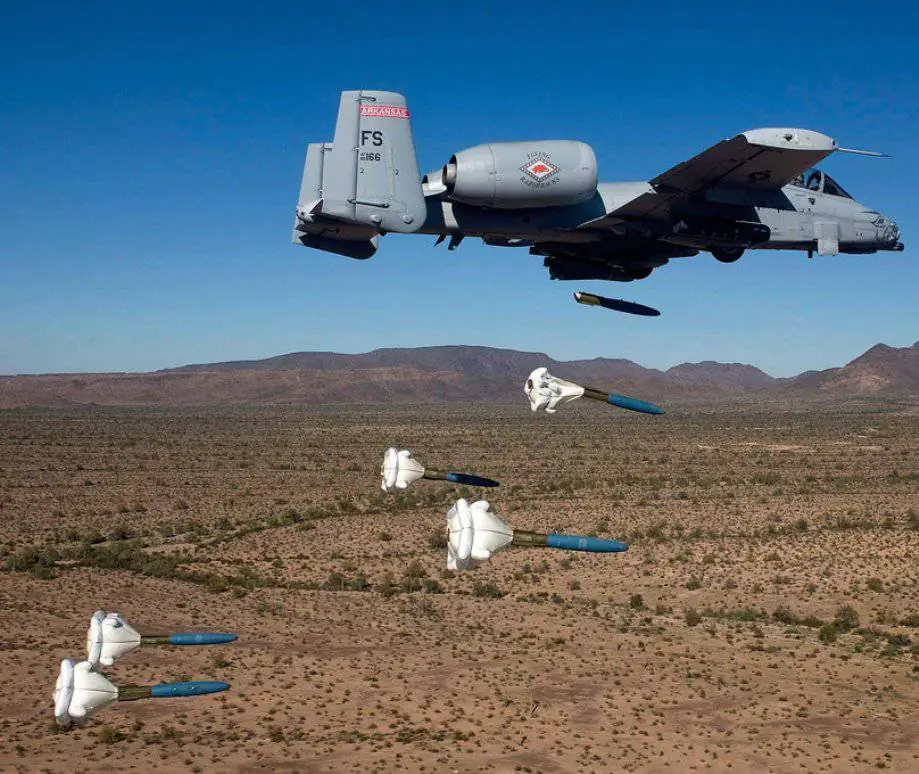
The store holds 1350 cartridges. The pilot can choose a rate of fire of 2100 or 4200 rounds per minute.
Recommended reading: All about the General Atomics MQ-9 Reaper
A-10 Thunderbolt II engines
The legendary attack aircraft is adapted for flights from unprepared airstrips with a high risk of damage to the engines by foreign objects. The unusual location of the General Electric TF34-GE-100 engines allows them to operate while the aircraft is being serviced and re-equipped by ground crews, reducing turnaround time. The engines’ high twin-loop ratio (6:1) contributes to a relatively small infrared signature, and their location directs the exhaust gases over the tail, further protecting them from detection by infrared surface-to-air missiles. The engine exhaust nozzles are angled 9° below the horizon to eliminate the nose-down moment that would otherwise be created if mounted above the aircraft’s center of gravity.
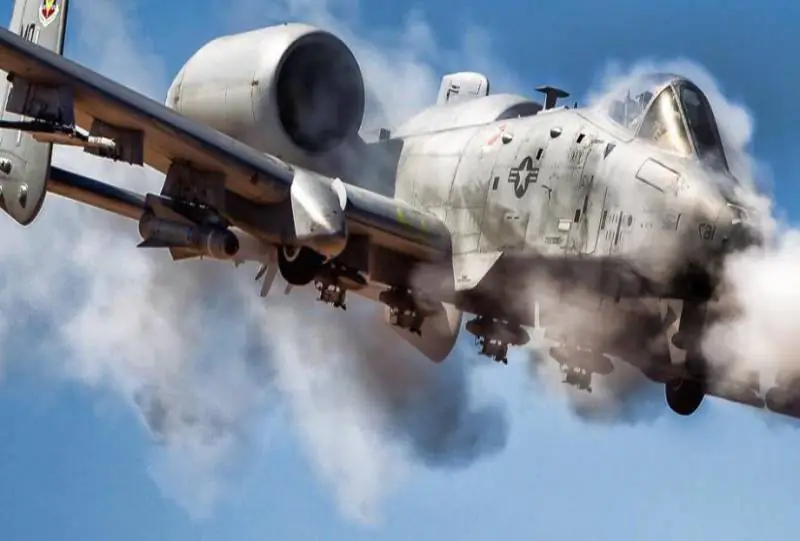
To reduce the chance of damage to the attack aircraft’s fuel system, all four fuel tanks are located in the center of the aircraft and separated from the fuselage, so the projectiles must penetrate the skin of the aircraft before reaching the tank. Damaged fuel lines are self-sealing. If the damage exceeds the self-sealing capabilities of the tank, check valves prevent fuel from entering the damaged tank.
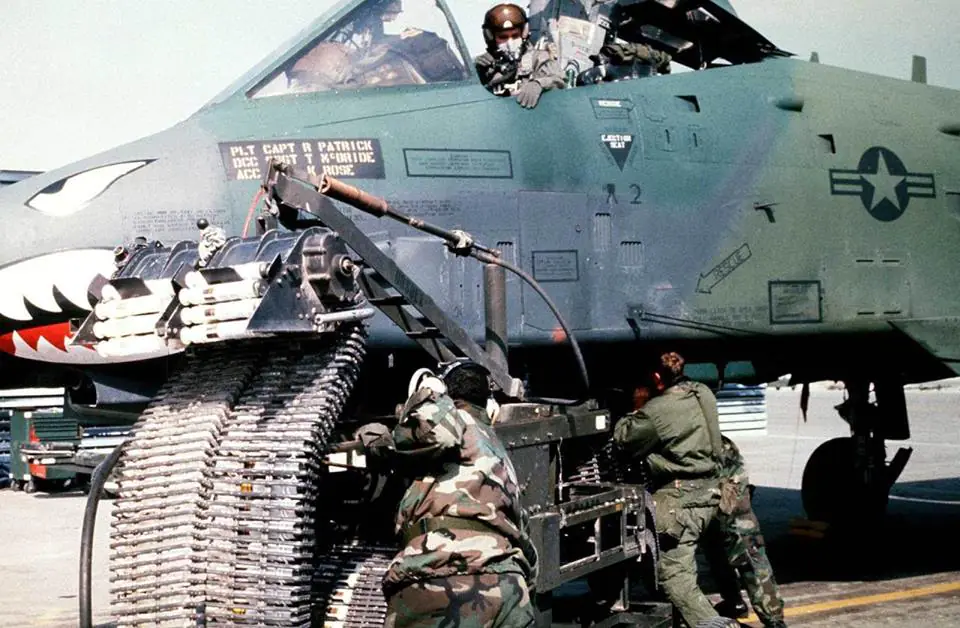
Most of the fuel system components are inside the tanks, so fuel will not be lost due to component failure. The filling system is cleaned after use. Mesh polyurethane foam lines the interior and exterior of the fuel tanks, containing debris and limiting fuel spillage in the event of damage. The engines are protected from the rest of the aircraft by fire partitions and equipped with fire extinguishing equipment.
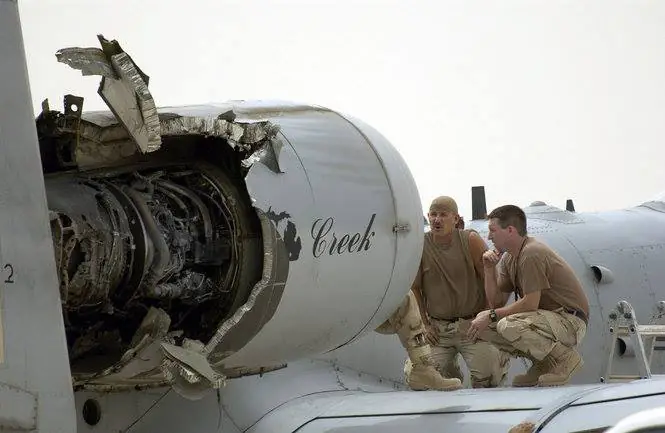
Recommended reading: Switchblade: American kamikaze drones to protect Ukraine
Key features of the A-10 Thunderbolt II
- Primary Function: A-10 — close air support, OA-10 – airborne forward air control
- Crew: One
- Cruising speed: 560 km/h
- Maximum speed: 706 km/h
- Combat range: 400 km
- Ferry range: 4,150 km
- Service ceiling: 13,700 m
- Rate of climb: 30 m/s
- Length: 16.26 m
- Height: 4.47 m
- Wingspan: 17.53 m
- Wing area: 47.01 m²
- Weight: empty: 11321 kg,
- Gross weight: 13,782 kg
- CAS mission: 21,361 kg
- Anti-armor mission: 19,083 kg
- Powerplant: 2 × General Electric TF34-GE-100A turbofans
- Thrust (power): 2 × 40.32 kN
- Gun armament: 1 × 30 mm GAU-8/A Avenger
- Ammunition: 1,174 rounds
- Hardpoints: 11
- Weight of suspended elements: 7260 kg
History of operation
The aircraft was used extensively during Operation Desert Storm, supported NATO operations in Kosovo, Operation Enduring Freedom in Afghanistan and Operation Iraqi Freedom.
The first combat use of the A-10 Thunderbolt II attack aircraft took place in 1991 during Operation Desert Storm. In total, the US Air Force involved 144 A-10 attack aircraft in this operation, which flew 8,100 sorties. At the same time, 7 attack aircraft were lost (an average of 1 loss per 1350 sorties). To the surprise of many observers, the outwardly nondescript attack aircraft became the real hero of this campaign along with the F-117 “stealth” strike aircraft and the F-15 fighter. According to the American military, during the operation, the attack aircraft destroyed more than 1,000 Iraqi tanks, as well as 2,000 units of other military equipment and about 1,200 artillery guns. That is, the A-10 Thunderbolt II proved to be the most effective aircraft in this war, surpassing even the specialized AN-64 Apache anti-tank helicopter. The combat efficiency level of the aircraft during the operation was 95.7%, which also turned out to be a record among all tactical aircraft of the US Air Force.
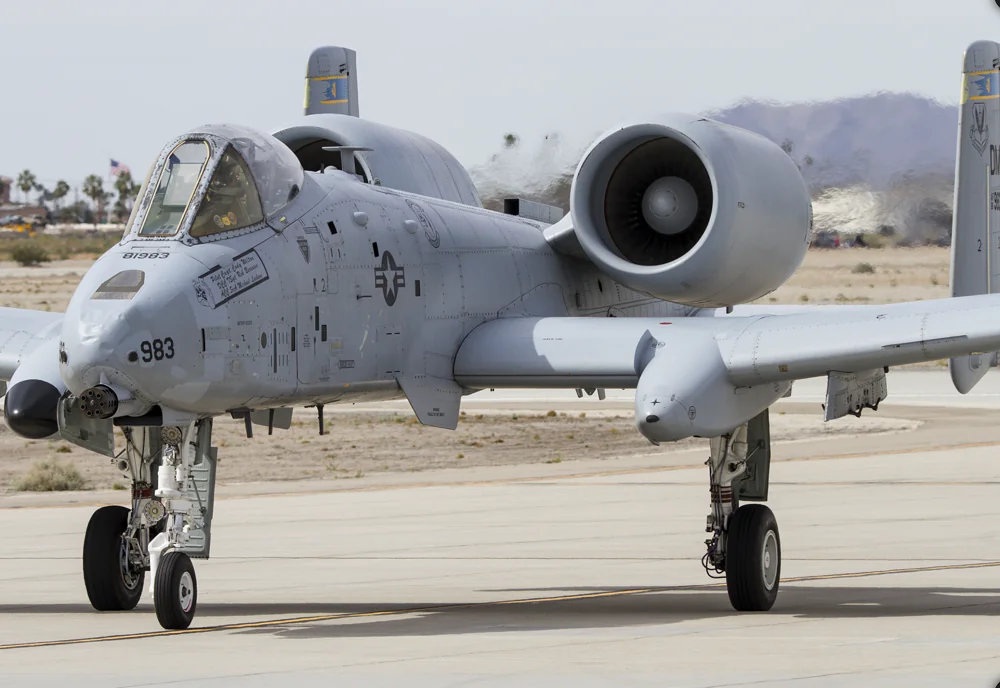
In one of the sorties, a pair of A-10 Thunderbolt II attack aircrafts was able to destroy 23 Iraqi tanks and damaged another 10 stationary, 3 mobile and 3 temporary launchers. Also, during the hostilities, the attack aircraft shot down 2 Iraqi helicopters: Mi-8 and, presumably, the MBB Bo 105. During the operation “Desert Storm”, the survivability of the attack aircraft was proven for the first time. According to aviation technicians, no other aircraft could have returned to base with the same damage as the A-10.
The aircraft’s only “weak point” in this operation was its propensity for “friendly fire” episodes, which later appeared in other conflicts. This was caused, first of all, by the specifics machine operation, which always works in close proximity to its troops. In late January, during the battle for Ras al-Khafji, an A-10 Thunderbolt II attacked a US Marine Corps LAV-25 APC with a Maverick missile, resulting in the destruction of the APC and the loss of 7 lives. A month later, an A-10 attacked British infantry fighting vehicles, resulting in the death of 9 soldiers.
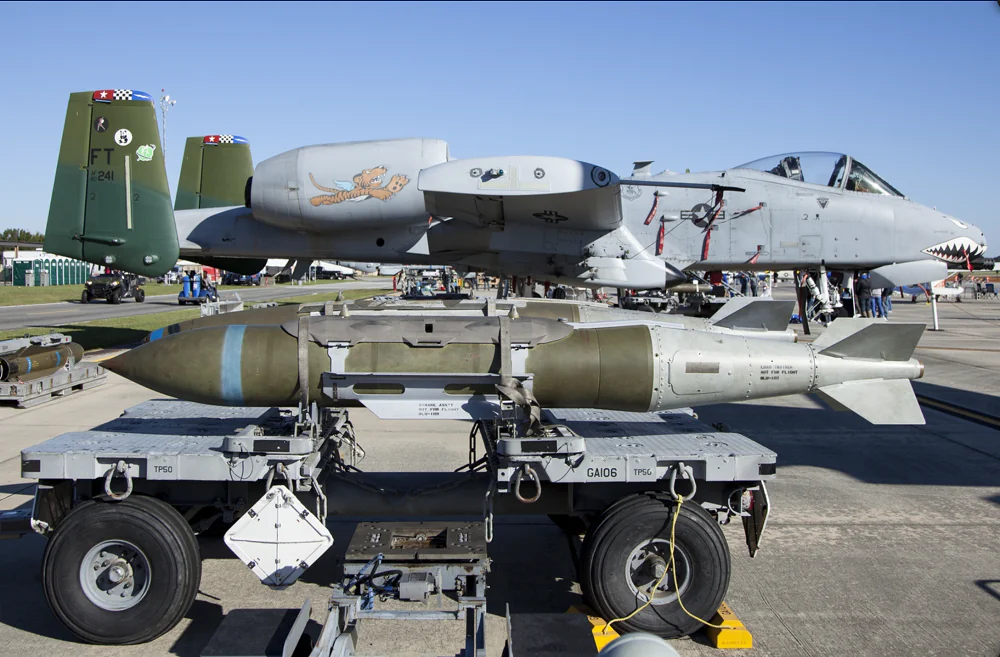
A-10 attack aircraft also took part in NATO’s military operation in the former Yugoslavia in 1999, taking off from air bases on the territory of Italy. According to official information, there were no losses of these aircraft during the conflict.
Later, the attack aircraft took part in the NATO operation in Afghanistan in 2001, and then in Iraq in 2003. During the operation, one plane was shot down by Iraqi air defense near the Baghdad airport. Another plane, piloted by a female pilot, Kim Campbell, was seriously damaged (hydraulic system failure, one engine damaged, hundreds of holes in the fuselage, and wings), but was able to make it to its home airfield. After the end of the active phase of hostilities and the beginning of the guerrilla war, the A-10 aircraft continued their sorties.
Recommended reading: Saab JAS 39 Gripen as an option for Ukraine’s Air Forces: what kind of plane is it?
Will the “Warthog” help us and should we count on it at all?
This question has long been the subject of discussions on the Ukrainian segment of the web. Opinions were divided. Let’s try to analyze the positive and negative aspects of the appearance of the A-10 Thunderbolt II in service of the Ukrainian Air Force.
Undoubtedly, the acquisition of any aircraft, especially such a legendary attack aircraft, is a big plus for Ukrainian armed forces. We catastrophically lacking the proper aviation. Especially if you take into account the successful combat experience of the A-10 Thunderbolt II. In addition, this attack aircraft can take off even from poorly prepared front-line airfields or highways. That is, we would be able to locate the base of attack aircraft in the immediate vicinity of the combat zone and save fuel. The armament of this attack aircraft is also impressive, although not as modern as that of the same fourth-generation fighters, but it is capable of destroying columns of Russian armored vehicles.
The ability to use high-precision weapons can also be an advantage. It must be admitted that AGM-65 Maverick anti-tank missiles with a flight range of about 30 km, JDAM high-precision bombs, and, of course, the 30-mm seven-barreled GAU-8 Avenger gun with a rate of fire of 3900 shots per minute are more effective than the weapons of our Su-25s, which, nevertheless, work quite successfully against the occupiers.
Almost everything is perfect, right?
But there are negative nuances. First of all, this is the age of the attack aircraft. Let me remind you, he is turning 50 years old. Yes, it is modernized, received a lot of improvements, but it is already outdated. Due to its exceptional survivability, ease of maintenance, low maintenance cost and proven combat effectiveness, it is still in service in the US. And it will be in service at least until the 2040s.
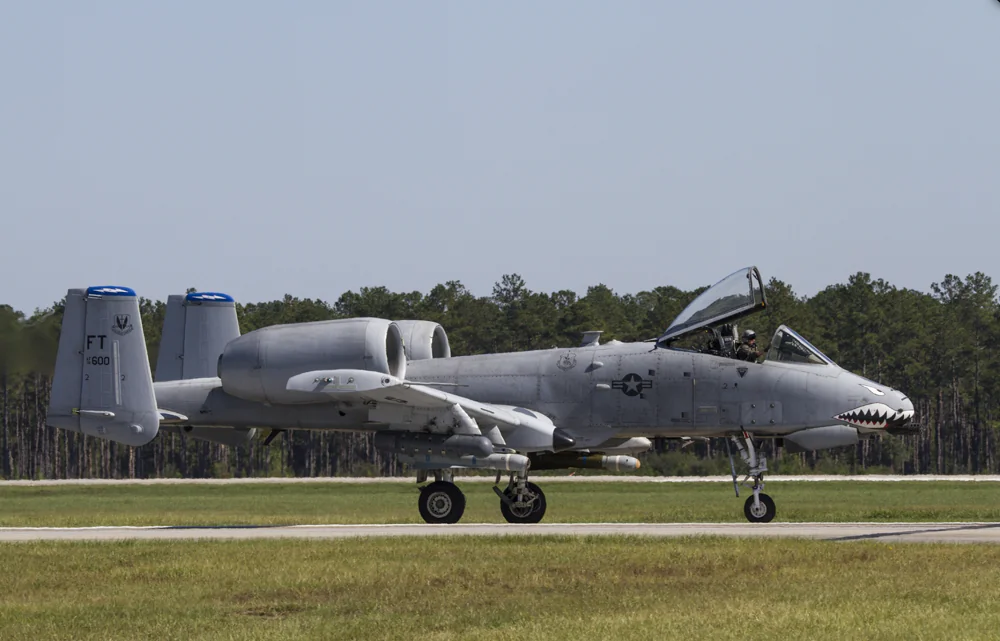
Secondly, many remember his ground successes during “Desert Storm”, where every sortie of the A-10 Thunderbolt II was a real terror for the Iraqi forces. But everyone forgets the fact that the US and coalition forces had complete superiority over the enemy precisely in the air. That is, the A-10 Thunderbolt II was reliably protected by fighters, so it calmly flew and destroyed enemy tanks and armored vehicles, without the threat of being intercepted by enemy fighters, and in some sectors there were sometimes no Iraqi air defenses at all. That is why there are such successes in this operation. And now let’s look at the situation in the Ukraine. We all know very well that the Armed Forces and the Air Force do not have superiority in the air, on the contrary – our enemy has an almost complete advantage in terms of the number of aircraft. In this situation, American attack aircraft will become an easy target for Russian fighters. I don’t think the Americans will be pleased to hear that the Su-34 easily handled the A-10 Thunderbolt II. This may become an excuse for Russian propagandists to tell us that the US is giving us old attack aircrafts that are easy to shoot down and there is no use for them. In order to effectively work against the enemy’s columns, next to the A-10 Thunderbolt II should also be our fighters. Can we afford it?
Let’s be honest, if Ukraine has a choice between fighters and attack aircraft, or even if there is an opportunity to take both types, it should obviously not be made in favor of the A-10. We need to gain an advantage in the air, and constantly work on the accumulation of ground equipment of the Russian forces. And this is possible only thanks to modern universal Western fighters, which could impose a battle on the Su-34, and prevent the occupiers’ helicopters from attacking our positions with impunity and smearing the occupier’s ground equipment. Yes, it is very cool to have several specialized types of aircraft for different tasks, but only a state with a huge defense budget can afford this. This is not about Ukraine. We should invest in a single universal aircraft – F-15, F-16, F-18 or Gripen.
But in any case, we need planes, because without them it is difficult for us to destroy the influx of invaders. The victory will certainly be ours! Glory to Ukraine! Glory to the Armed Forces! Death to enemies!
Read also:
- “Neptunes” knocked out “Moskva” cruiser: All about these anti-ship cruise missiles
- Weapons of Ukrainian Victory: NASAMS air defense that protects Washington
You can also help Ukraine fight with Russian occupants via Savelife or via an official page of the National Bank of Ukraine.

